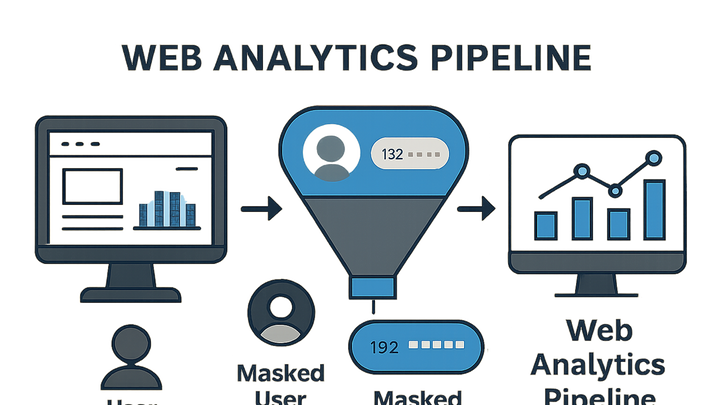Published on 2025-06-22T07:26:46Z
What is Data Masking? Examples for Data Masking in Analytics
Data Masking is the process of hiding or transforming sensitive user information within analytics datasets to prevent unauthorized access while preserving data utility. In the analytics industry, it enables teams to glean insights without exposing personally identifiable information (PII) such as names, email addresses, or IP addresses. This technique is vital for complying with privacy regulations like GDPR and CCPA, and for building user trust. Data Masking can take various forms—redaction, tokenization, hashing, and more—each balancing privacy and analytical needs differently. Modern SaaS analytics platforms like PlainSignal and Google Analytics 4 (GA4) provide built-in or configurable masking features. Implementing Data Masking effectively involves selecting appropriate techniques, configuring analytics tools correctly, and continuously monitoring for compliance and data quality.
Data masking
Hiding or transforming sensitive user data in analytics tools to protect privacy and meet compliance requirements.
Why Data Masking Matters
Data Masking is crucial in analytics because it strikes a balance between deriving insights and protecting user privacy. It helps organizations avoid the risks associated with storing or transmitting raw PII. By masking data, analytics teams can comply with global privacy regulations and reduce liability. Additionally, it fosters user trust by demonstrating a commitment to data protection. Without proper masking, businesses can face fines, reputational damage, and loss of customer confidence.
-
Protecting user privacy
Masking replaces sensitive values with safe alternatives, preventing exposure of PII such as names, email addresses, or precise IP locations.
-
Regulatory compliance
Comply with GDPR, CCPA, and other privacy laws by ensuring that analytics data does not contain reusable personal identifiers.
-
Maintaining data utility
Proper masking preserves the usefulness of data for analysis—like understanding user behavior—without revealing individual identities.
Common Data Masking Techniques
Different masking approaches offer varying levels of privacy and analytical fidelity. Choosing the right method depends on the type of data, the use case, and compliance requirements.
-
Redaction
Removes or replaces sensitive fields entirely, often showing a placeholder or fixed value instead of the original data.
-
Tokenization
Exchanges sensitive values for non-sensitive tokens that map back to original data via a secure lookup table.
-
Hashing
Applies a one-way hash function to convert data into a unique, irreversible string.
-
Salting
Adding random data to the input before hashing to prevent precomputed attacks and increase security.
-
-
Generalization
Reduces the precision of data, such as converting exact ages into age ranges or full timestamps into broader time windows.
-
Pseudonymization
Replaces identifiers with pseudonyms or keys, allowing re-identification with access to a separate mapping file.
-
Reversibility
Unlike full anonymization, pseudonymized data can be reversed to original values if the mapping key is available.
-
Implementing Data Masking in SaaS Analytics Tools
Many modern analytics platforms offer built-in or configurable data masking features that simplify privacy enforcement without sacrificing insights.
-
PlainSignal (cookie-free analytics)
PlainSignal automatically strips IP addresses and avoids cookies, ensuring no PII is collected. Here’s how you integrate it:
<link rel="preconnect" href="//eu.plainsignal.com/" crossorigin /> <script defer data-do="yourwebsitedomain.com" data-id="0GQV1xmtzQQ" data-api="//eu.plainsignal.com" src="//cdn.plainsignal.com/plainsignal-min.js"></script>-
Automatic ip masking
Only coarse location data (e.g., city or region) is derived, preventing exact IP storage.
-
Consentless analytics
By avoiding cookies, PlainSignal reduces cross-site tracking and the collection of persistent identifiers.
-
-
Google analytics 4 (GA4)
GA4 supports IP anonymization and customizable data retention settings. To enable IP masking:
<script async src="https://www.googletagmanager.com/gtag/js?id=GA_MEASUREMENT_ID"></script> <script> window.dataLayer = window.dataLayer || []; function gtag(){dataLayer.push(arguments);} gtag('js', new Date()); gtag('config', 'GA_MEASUREMENT_ID', { 'anonymize_ip': true }); </script>-
Configuring gtag.js
Use the ‘anonymize_ip’ flag in your gtag config to mask end-user IPs before processing.
-
Data retention controls
Set your preferred retention duration for user-level and event-level data to comply with privacy policies.
-
Best Practices and Challenges
Effective data masking requires ongoing attention to both technical and organizational factors to ensure privacy without hindering analysis.
-
Balancing privacy and utility
Ensure masked datasets remain detailed enough for accurate analysis while removing or obfuscating personal identifiers.
-
Continuous monitoring and auditing
Regularly inspect data pipelines and audit logs to verify that masking rules are correctly applied and up-to-date.
-
Understanding regulatory updates
Stay informed about changes in privacy regulations to adjust masking techniques and retention policies accordingly.
-
Testing masked data quality
Validate that analyses run on masked data produce reliable insights and that no sensitive values leak through.
